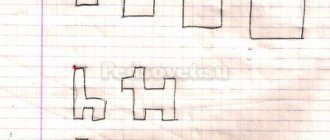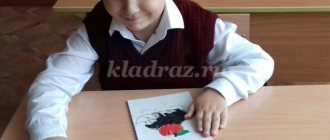BENEFITS OF EXERCISE
Games and exercises that develop fine motor skills should be carried out with the child on a regular basis, as they not only improve the baby’s ability to work with his fingers and hand, but also stimulate speech development.
Without such activities, there is a risk that the child will be unprepared for school, his hand will not be able to hold a pen or write correctly. And the child himself may find himself helpless and experience difficulties in performing such basic actions as tying shoelaces.
Daily exercise will help improve attention and memory. Gaming technologies are diverse, so any parent can choose exercises to their liking.
FINGERS PLAYING
However, the most interesting activity for children is finger games: all kinds of rhymes, tongue twisters, nursery rhymes, mini-performances that are performed only with the help of fingers. Here we present several new options for finger games.
But first, here are a few rules for conducting activities that develop fine motor skills:
- Work with your child regularly, include hand massage, games with small parts, creative activities, and finger exercises in your training program.
- Finger gymnastics should last from 5 to 15 minutes, no more, otherwise the baby will get tired and switch his attention to something else.
- Before starting the exercises, you need to warm up your palms by actively rubbing them against each other.
- Remember that now it is difficult for children to perform movements with both hands at once, so start with one, then repeat with the other, and only after that try to synchronize the hands.
- Keep in mind that the child may not remember all the movements or words of the game the first time, this is normal at their age. Everything will work out gradually.
- The baby will also learn to correlate words with movements during the lessons; if he doesn’t succeed right away, encourage him and help him perform the action.
- Move from simple to complex. If a child is offered an exercise that he cannot do, next time he will simply refuse to play.
- Try to interest your child by organizing games with his favorite characters, melodies, and rhymes.
- Do not exercise if your baby is unwell or in a bad mood. Don't force it. There are no useful games against the will of the player.
BASIC GAMES
Parents should prepare in advance a set of games that will help their 4-5 year old child develop the ability to work with fingers and perform small movements. There are a great variety of similar exercises; almost all the tools can be created from improvised means.
You can offer the following options for exciting games.
- With cereals and large objects (for example, a button, a bead). The parent takes a deep bowl, fills it with cereal, into which he buries several buttons. The baby’s task is to find and get them.
Advice
For this exercise, you can use almost any cereal: rice, peas, buckwheat.
- Untying knots. You need to start with simple ones, using a thick rope, gradually complicating the task.
- Labyrinth. An adult draws a “labyrinth” on a piece of paper, and the child’s task is to walk through it with the index and middle fingers, imitating steps.
These exercises develop the hand and fingers well.
WE MAKE EXERCISES
To teach a child to use a brush and make movements with his fingers, parents will have to try and be patient, because not everything will work out the first time. To prevent your baby from losing interest, it is important to offer him a variety of exercises. Therefore, moms and dads will have to create exercise equipment with their own hands. There are many options.
The bird is made like this:
- take a cardboard box (for example, pizza, candy).
- an image of a bird is applied to it, preferably large in size (the bird can be pasted on or drawn);
- A hole is made in the cardboard near the beak.
The baby’s task is to lower one grain into the hole (to feed the bird).
In a similar way, you can feed the worm peas.
A simulator with bands can be done like this:
- several satin ribbons are attached to a vertical surface (you can sew them to a special rug, which you hang on the wall so that the baby can easily reach it);
- A small wooden stick is glued to the other side of each ribbon (you can use a popsicle stick).
The child’s task is to try to twist the ribbon.
Children are also very fond of homemade lacing, exercises with which contribute to the formation of a very important skill - lacing shoes.
You can make an interesting activity yourself from felt - cut out a hedgehog figurine and fruit, inviting your child to place the “prey” on the hedgehog’s spines.
You can purchase special educational toys in the store - construction sets, mosaics, puzzles, pyramids, and a magic basket.
Useful toys
- Pyramid.
- Sorter.
- Mosaic. Any, all kinds of shapes, materials, sizes!
- Magnetic construction set and magnetic mosaic (magnetikus type).
- Construction set with hammer and nails on a cork board.
- Designer with large screws.
- Lego Duplo and classic Lego (as soon as the child stops tasting the parts).
- Play-Doh modeling kits (or cheap equivalents).
- Montessori toy sets. For example, special tongs and tweezers for carrying objects.
- Toys with Velcro.
- Business boards.
MOST POPULAR GAMES
The game catalog contains a huge number of options. We offer some simple finger games that are loved by most children.
- Squeeze all the fingers on both hands, then unclench them. Run several times.
- Squeeze the fingers on your right hand and unclench them one by one. Repeat the exercise with the left.
To make it interesting for the child, during the lesson the parent can read funny poems to him or write a story about how a fairy-tale character (a bear) got home with the help of finger movements. For example: the bear passed the first forest - extend one finger. The bear passed the second forest - we unbend the second one. The child will try to do the exercise to find out how the fairy tale ends.
- "Fan". The exercise is useful for the fingers; it is performed like this: press your fingers together (imitating a closed fan), then spread them as wide as possible (the fan has opened), and wave your hand.
- A very good exercise that helps develop not only motor skills, but also attention and reaction speed - “Scratch-scratch”. The parent places his hand on the table, the baby places his palm on the adult’s palm and listens to him. Mom or dad tells a poem or a fairy tale, the child’s task is to be attentive. As soon as “tsap-scratch” is heard (this can be any other phrase discussed in advance), he needs to remove his palm as quickly as possible, otherwise the parent will cover it with his other hand. After a few practices, parent and baby can switch roles.
- "Butterfly". First, the fingers are clenched into a fist, now you need to straighten the little finger one at a time, then the ring and middle fingers. Create a ring from the index finger and thumb. The butterfly is ready. Now you need to ask the child to “flap his wings” - make movements with straight fingers.
If one of the finger games causes difficulty, you can replace it with another for a while; you should not torment your child with a mandatory mindset for success.
FIRST CLASSES WITH SUBJECTS
Having learned the basic games with fingers, you can move on to the next step - practicing with objects. For the little ones, such developmental exercises will be useful.
- Working with a pencil and small hair ties. The parent holds a pencil in his hand. The child’s task is to put several small rubber bands on him one after another.
- Drawing with semolina. The parent pours a thin layer of cereal onto a flat plate or cutting board, inviting the baby to run his finger over it. You will get a line. In the same way, the child draws several stripes on the semolina.
- Laying out the beans. The mother gives the baby a small handful of beans (beads or buttons can replace them). The preschooler is required to lay it out on the table in piles or make a path.
- Working with beads, stringing large elements. They can be replaced with pasta pre-dyed in different colors.
- Working with buttons. The parent draws a circle on a piece of paper. The child is given instructions to arrange buttons, paper clips, and beans along its contour.
- Children love to imitate adults, and this should be used in organizing classes. So, the mother can invite the baby to stir the sugar in his tea himself.
- "Firework". The baby’s task is to tear a sheet of paper into as small pieces as possible and fold them on the table. Then these scraps are held in the hands and tossed, like a real fireworks display.
The main rule is to practice every day, but do not force the baby. Training should bring joy, not irritation.
RULES FOR PERFORMING FINGER EXERCISES
Working with the baby on the development of fine motor skills should be carried out on a regular basis, but not tire the child. The easiest way to do it is with finger games, which perfectly stimulate the brain and help develop dexterity, attention, and memory. The work is carried out first with the right hand, then with the left. An adult is required to monitor the correct execution of the movements, so before showing them to a child, you need to practice yourself.
Advice
You should start with 2-3 repetitions of each exercise, gradually increasing them to 5-8. Training is carried out daily, and a few minutes a day is enough.
Didactic manuals advise: if the child gets tired, the lesson can be broken up. Do the first two exercises in the morning, two more in the afternoon, and one in the late afternoon.
WHAT CONTRIBUTES TO HANDBOOK DEXTERITY?
There are many ways to make little fingers more skilled. The following games and activities perfectly develop fine motor skills in children aged 3–4 years:
- fastening buttons, snaps, lacing;
- unscrewing lids on jars and bottles;
- rolling pencils, nuts, spools in the palms;
- modeling from plasticine or dough;
- sorting of cereals (peas, beans, buckwheat, rice);
- finger painting on sand, semolina or buckwheat;
- drawing with finger paints or pencils;
- cutting out figures along the contours;
- games with small details (constructor, mosaic, puzzles);
- stringing large beads on fishing line or wire;
- feeling surfaces made of various materials and textures;
- massage with spiked balls.
When your child paints with finger paints, put on things that you don’t mind getting damaged by paints, and cover the table with protective oilcloth to make subsequent cleaning easier.
Most of these activities captivate children 3–4 years old, especially if parents give them the form of an entertaining game. For example, they suggest not just sorting out the cereals, but helping Cinderella go to the ball, not just touching different surfaces, but imagining yourself as a blind Mole from the fairy tale about Thumbelina, and guessing what you touched.







